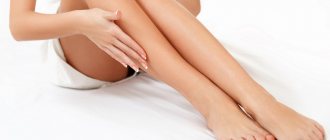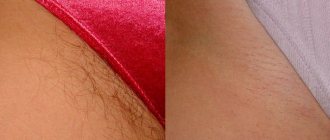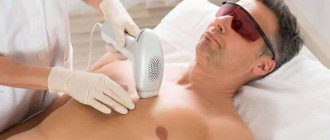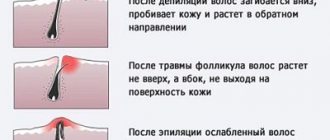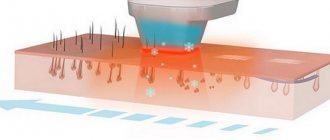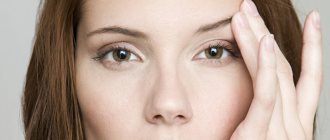Description of the procedure
Laser hair removal removes excess hair. This happens due to the effect of a laser beam on the hair follicles, they are cauterized and destroyed. After a laser hair removal session, the treated area slows down and then completely stops hair growth.
In one session, the laser beam only treats a certain area that it covers, so one procedure does not give the full effect. In one procedure you can get rid of unwanted hairs above the upper lip or in the armpits.
When epilating the bikini area or legs, you will need to repeat the procedure, the frequency of which depends on the individual characteristics of the person, skin type, hair thickness, etc.
Laser hair removal should be carried out only in institutions that specialize in cosmetology and have in their arsenal professional craftsmen and the necessary equipment for hair removal. In addition, the clinic must have a license to practice cosmetology and use a laser device in particular.
Causes and mechanisms
Depilation involves removing only the outer part of the hair, leaving the root intact. If the rod is dark in color, it will still be slightly noticeable against the background of light skin. This is a common condition accompanying depilation. There may be another situation, for example, when the hair bends and re-embeds its tip into the skin, forming a kind of loop.
Dark spots that appear after hair removal often indicate ingrown hairs. A root that has been destroyed will still regenerate over time, but the direction of the rod may change (not upward, but sideways). Violation of natural hair growth certainly requires further correction.
If the epithelium is thick enough, then even normal hair will have difficulty breaking through it after epilation. This creates conditions under which an inflammatory process occurs. While it is aseptic in nature, the addition of microbial flora (for example, when scratching) can cause pustules. Then the black dots become covered with pustules, turning from spots into tubercles filled with yellow exudate.
The cause of black spots on the legs is the consequences of hair removal - improper growth, bending, inflammation.
Hair removal was successful - how to take care of your skin next?
After the procedure is carried out by a good specialist who complies with all technologies and safety measures, hair removal will not leave burns on the body or other negative consequences. It is enough just to take care of the treated area according to a specific plan, then the skin will quickly recover after the procedure and will delight you with its attractive appearance and smoothness.
In the first hours after the laser
- Immediately after the procedure, the skin requires cooling. You can cool and soothe it with ice cubes wrapped in soft cloth or gauze. Do not apply ice directly to irritated skin, only through a cloth or napkin. Otherwise, you can provoke hypothermia or frostbite on a vulnerable area of the skin.
- If there is burning and discomfort in the treated area, you can take a paracetamol tablet, it will help relieve these symptoms.
- If hair removal was carried out on areas of the face and you need to apply makeup, this should be done carefully, with soft and smooth movements. Careless and rough application of makeup can cause unwanted friction, which increases the risk of scarring on the skin.
Sometimes, swelling forms around the follicles, which is expressed as “goose bumps”. They need to be treated with aloe vera-based ointment, this is necessary so that a crust does not form in those places.
If a crust suddenly appears, you cannot rip it off; you need to wait until it separates from the skin at will. Any other creams other than this ointment should not be rubbed in, nor should you shave the damaged area of the skin until it is completely healed, in order to prevent unnecessary injuries and infections.
1 day later
After laser hair removal, you should refrain from taking a hot shower or bath, and from using alcohol-based cosmetics.
2 days later
After 2 days have passed, you can use deodorant, perfume and whitening creams. Sports and intense physical activity should also be postponed for 2 days, as sweating occurs, body temperature changes, and blood vessels dilate. This can be harmful to damaged skin and will slow down its healing.
If hair removal was carried out on the face, it must be protected from ultraviolet rays; the same creams can be used in between laser hair removal sessions.
3 days later
For three days after laser hair removal, you should not come into contact with chlorinated water, and you should avoid swimming in pools. Rough and hard clothing should be replaced with soft fabrics that do not exert friction and pressure on the skin.
1 week after laser hair removal
After the skin has become smooth and silky after the procedure, you really want to visit the beach and show off the amazing result. But you need to wait 1 week for the skin to calm down, irritation and increased sensitivity to subside. The sun's rays can increase irritation and redness, and the risk of burns in the treated areas increases.
Lose weight without denying yourself your favorite foods! Eat and lose weight! Find out how! >>
After a week, you can visit the beach, but using maximum protection sunscreen.
After laser hair removal, it should take a little time before all the hairs fall off the skin. Many women resort to tweezers to quickly remove dead hair.
But this cannot be done; open pores can become infected, causing the development of purulent wounds. It’s better to wait a little and the hairs will fall out on their own without causing harm to the skin.
After 2 weeks
The hairs will disappear completely after 12-14 days; you can speed up the process of hair loss with the help of a soft scrub that will not scratch the skin. Scrubs with coffee particles and acids are not suitable. After 14 days, you can use a harsher scrub.
After 3 weeks
For the first three weeks after laser hair removal, when walking in the sun, you should use a sunscreen with a high degree of protection.
Continue removing hair with sugar or wax
One month before the start of the course and in between sessions, hair should not be removed from the roots. If you want to get rid of hair for a long time, forget about wax, sugar paste, tweezers and electric epilator. Otherwise, new follicles will appear in place of the destroyed follicles, and the hair will resume growth. You can temporarily switch to a depilatory cream or razor without fear that irritation will appear or the hair will not become stiffer, and after completing the course, maintain the result by repeating the procedure several times a year.
What not to do
After the first laser hair removal session, the clinic specialist gives recommendations that must be followed. The most important points are to avoid visiting baths and saunas and tanning, that is, the skin should not receive additional heat. So what should you do after the procedure to avoid harming the epidermis?
Water treatments
Laser hair removal feels like a tan on the skin. After the procedure is completed, a special product is applied to the skin to promote healing. This is why you should avoid hot baths and showers for three days after hair removal.
Lose weight without denying yourself your favorite foods! Eat and lose weight! Find out how! >>
Swimming pool, sauna and bathhouse
It was said above what you should avoid for the first time after laser hair removal. These questions are worth examining in more detail in order to understand why it is necessary to limit certain procedures that have become part of familiar, everyday life.
Exposure to hot temperatures on the treated surface of the skin may have a detrimental effect on it. After all, during laser hair removal, the skin is exposed to a light beam, becomes irritated and sensitive to high temperatures. That is why not only hot home baths are contraindicated, but also visiting a bathhouse, sauna and steam room. Steam rooms and baths should be postponed for at least 2 weeks, depending on the individual characteristics of the skin.
Interesting fact: laser hair removal procedure is popular not only among women. Men began to use this procedure because it can help you get rid of hair in hard-to-reach places. Laser hair is removed from the back, groin, buttocks, nose and ears. But the skin care rules for women and men are the same.
The pool also needs to be put aside; the water there is treated with chlorine, which has an aggressive effect on healthy skin, and is doubly stronger on areas subject to hair removal.
Based on this, many people wonder whether it is possible to wash at all after a laser hair removal procedure. Of course, you can and even need to wash yourself, since dirty skin develops bacteria that cause infections. But water procedures should only take place in warm water.
Alcohol-containing cosmetics
Having dealt with the issue of taking a bath and shower, the next question arises. What cosmetic products can I use after laser hair removal?
- After hair removal, the hair follicles open and can become a “gateway” for any infection. It is for this reason that you cannot use cosmetics for 3 days, since almost all of them contain alcohol. You can only use healing creams or ointments that are recommended by the cosmetologist who performed the hair removal.
- Alcohol products applied to treated areas increase the risk of dry crusts on the surface of the skin, ulcers and burns. The skin will experience discomfort and the healing process will be delayed.
- After hair removal, you should not apply products containing glycolic acid and retinol. These substances affect the skin, as a result of which it loses its protective properties for some time. The skin becomes more vulnerable to infections and environmental influences; skin that has experienced stress from laser hair removal is unable to resist negative factors.
Eliminate heat exposure
The skin turns slightly red after laser hair removal; this is a natural response to the laser. Follicles and skin melanin absorb the energy of the beam and respond with slight inflammation, which will go away on its own after some time.
After a few hours, the skin will regain its normal tone, but it must be protected from overheating and exposure to high external temperatures. Otherwise, redness may return again and the skin will require gradual cooling.
Apply medicinal products to the skin without consulting a specialist
Laser hair removal requires follow-up care of the treated areas. One of the points in skin care is the application of medicinal products. After the procedure, the cosmetologist will recommend a drug that should be carefully applied to the epilated areas for three days. Most often, the drug contains panthenol, which promotes skin healing.
It is prohibited to take medications on your own; it is better to consult a specialist.
Lose weight without denying yourself your favorite foods! Eat and lose weight! Find out how! >>
Why you can't sunbathe
Previously, the question of why you should not sunbathe before hair removal was considered. But even after it, you should avoid sunbathing for at least three days.
The sun's rays can cause a burn, after treatment of which there is a high probability of scarring. Sunbathing is especially dangerous for people who have dark skin, as it tans quickly and the risk of burns increases. In addition to burns, age spots may occur. If unwanted pigment spots appear, you can get rid of them with bleaching agents containing azelaic acid or copper.
Laser hair removal consists of several sessions, during the break between them you also need to avoid tanning, and it is better to use sunscreen.
If laser hair removal is planned before a summer vacation, then the first session should be carried out at the beginning of summer, and the subsequent ones at the end of the beach season, when the tan begins to fade from the skin.
Solarium
In addition to natural sunlight, after laser hair removal, going to the solarium is contraindicated. Every woman wants to look attractive in any situation and at any time of the year, but laser hair removal and solarium cannot be combined. In a solarium, the skin essentially receives the same exposure to ultraviolet radiation.
Solarium without laser hair removal is a useful and pleasant procedure. In addition to a beautiful and even tan, the skin receives a dose of vitamin D, seratonin is produced, and skin defects become less noticeable.
But after the hair removal procedure, the effect will be exactly the opposite. The tan will lie unevenly as the treated areas of the skin will become more sensitive. And in the worst case, burns, pigment spots will appear in that place, and black dots will form in place of the follicle.
Another problem in combining hair removal and solarium is that before visiting the solarium, the cosmetologist applies special products to the skin. It takes time for them to completely “come out” of the layers of the epidermis, and perhaps by the time of the hair removal session the substance will still be in the skin and cause an allergic reaction.
In addition, laser hair removal will not bring the expected effect, since the hair follicles will be poorly destroyed.
How long should you not sunbathe after procedures?
Having figured out why you can’t sunbathe, you need to understand how long this restriction is in effect.
Cosmetologists recommend avoiding sunbathing for a month. After this, you can spend time in the sun, but first protect your skin with sunscreen.
The cream must have 30 or 50 SPF protection. Protection 30 means that the cream protects the skin from ultraviolet radiation by 97%, protection 50 by 98%. Such protection is especially necessary for sensitive skin and those with fair skin types.
A month of banning sunbathing is an average time, it all depends on individual characteristics and skin type. The lighter the skin, the longer the break. When going out in the sun, you need to remember that sunscreen lasts up to three hours on average. After sunbathing, you can apply aloe vera cream to your skin to speed up its healing.
Massage after the procedure
After laser hair removal, you cannot massage the treated areas of the body. If epilation of the intimate area or armpit area was carried out, then a general massage is acceptable.
If your legs have been epilated, you should not touch them, and you must ensure that massage oil does not come into contact with the skin of your legs, as it can cause irritation or an allergic reaction.
The direct effect of massage on areas of the skin that have undergone laser hair removal will lead to severe irritation, pain and long healing of the epidermis.
Skin care after laser hair removal (video):
Things to remember when using a razor
- The machine must be the most delicate, new, sterile and sharp. Since the skin is sensitive at this time and is easily subject to irritation and injury. The machine should cut the top part of the hair without pulling out the follicle.
- Before shaving, there is no need to steam the skin, since heating the skin is prohibited for 10 days.
- The area of skin that will be shaved should not be treated with alcohol. Thermal water or antiseptic agents that soothe the skin without irritating it are suitable.
- When shaving, you need to act carefully so as not to cut the skin, as the cut may become infected.
- You can shave the treated areas only after redness and other skin reactions to hair removal have completely subsided.
To summarize, we can come to the conclusion that shaving after laser hair removal is possible; it will not cause harm to the skin. Since hairs do not immediately die after epilation, the machine will help speed up the process and make the skin on the treated area smooth and soft. It takes about 2 months for the hairs to completely die and disappear; during this time, a machine will come in handy, which will remove unevenly growing hairs.
If the process of dying hairs does not cause discomfort, you can wait for their natural loss without resorting to the help of a blade. Between laser hair removal sessions, it is recommended to shave hairs whose follicles have not yet been destroyed; this should be done no more than once every 10 days.
Why should you not pluck your hair after laser hair removal?
Plucking hairs after laser hair removal is strictly prohibited. It is better to shave off the regrown hairs with a razor and conduct another laser hair removal session. There is no need to interfere with the process of follicle dying and pull out the hair with tweezers; besides, an infection can get into the open pore.
In addition to tweezers, it is prohibited to use wax strips and other alternative methods that pull out the hair along with the bulb. In the worst case, a response and protective reaction of the body may occur, which will provoke increased hair growth. This will require longer laser hair removal sessions, which means the skin will experience greater strain and stress.
10 main questions (video):
How is diode hair removal performed?
The procedure takes place in the following sequence:
- Skin testing and selection of the optimal laser treatment method, session duration, number of procedures;
- The skin area is treated with an antiseptic (bactericidal gel, spray, ointments);
- You need to lie horizontally on the couch, because... The session lasts about an hour;
- For safety, special glasses are required for the patient and the cosmetologist;
- Then the specialist works with a laser, treating the problem area;
- After completing hair removal procedures, it is necessary to treat the skin with a cream with an antiseptic, moisturizing, and soothing effect.
Possible consequences after hair removal
Laser hair removal is not only a cosmetic procedure, but also a medical procedure. And any medical intervention in the human body can provoke negative consequences, which are a response.
The most important thing is not to panic, since all the consequences of the procedure can be eliminated with the help of the recommendations of a cosmetologist and dermatologist. They will competently and professionally assess the situation and prescribe the necessary treatment.
- Sometimes hypopigmentation may occur, which is manifested by a decrease in the natural color of the skin. This is due to a decrease in the production of melanin, which colors the hairs and epidermis; this symptom does not cause pain and goes away on its own in about 20 days.
- Hyperpigmentation is the opposite phenomenon, when the skin color becomes brighter than the natural tone. Melanin production occurs twice as much, unevenly coloring areas of the skin in darker tones. This symptom can also occur, and after a certain time it will pass without causing pain or harm to the patient.
- Most often, after hair removal, redness of the treated areas of the skin occurs; it goes away within a few hours, or at most a few days. If this does not happen, then an allergic reaction has occurred and you need to seek help from a specialist.
- If you do not follow the advice and recommendations of a cosmetologist, swelling, burns or watery blisters may occur, causing infectious skin infections.
- People suffering from increased skin hair growth, before starting laser hair removal procedures, need to restore the hormonal balance of the body. If the production of hormones in the body is disrupted, hair removal is powerless; it will only reduce the number of hairs, but does not eliminate them completely.
- Negative consequences can be caused by unprofessional actions of a cosmetologist. You need to carefully choose a clinic, look at reviews about its work and the work of its specialists. The clinic must be licensed. When a clinic and hair removal specialist have been selected, you need to carefully monitor the preparation for the hair removal procedure.
A professional cosmetologist will initially test the laser and its effects on a small area of skin. This is necessary in order to understand what kind of anesthesia is required and what length of the light beam is required. Each client is individual in terms of skin type and pain threshold. The cosmetologist also applies special products to the treated area.
An important point is that glasses will provide reliable protection of the retina from the harmful effects of laser light; there is no need to give them up. After the procedure, the cosmetologist is required to apply a soothing agent to the skin, which will cool the skin and relieve irritation.
Harm of laser hair removal (video):
Laser hair removal will bring benefits and beauty, provided you choose a professional cosmetologist and complete all skin care items. You need to understand which specialist is entrusted with beauty and health, and take personal responsibility after the procedure, observing all the necessary rules for recovery.
Liked? Share with your friends!
What areas can be epilated using a diode device?
The cold type laser treatment technique is carried out taking into account the skin structure, hair length, health status and medication schedule of the patient. In the absence of contraindications, the technique is performed in the following areas:
- on the face, the cheek area, eyebrows, and skin above the upper lip are treated;
- body core (armpits, décolleté, back and chest);
- buttocks and bikini area;
- hands (elbows, fingers, etc.);
- on the legs, thighs, shins, ankles, and toes are treated.
